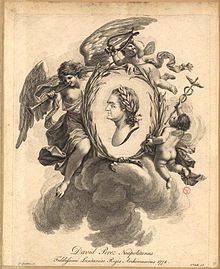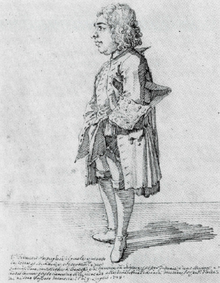Royal Patriarchal Music Seminary of Lisbon
[12] Historical analysis places emphasis on the fact that John V reigned according to the absolutist model of monarchy,[13][14] one which assumed the monarch to be ruling according to Divine Right and subject to no higher power except, ultimately, God's judgement.
Therefore, while the crown could seek advice or counsel from others, usually members of the nobility or aristocracy, he or she was not subject to follow their direction, nor was the monarch ever seen as a purely symbolic head of state as in a constitutional monarchy.
[15] Towards the end of Peter II's reign, alluvial gold was discovered in the Colony of Brazil and from that emerged a massive international trade which restored Portugal's wealth to the same level it had enjoyed in the 15th and early 16th centuries.
From John V's hands, a substantial amount of this money was mortgaged to the country's upper classes to advance their lifestyle, even more was spent by the king on state projects such as the complete rebuilding of the University of Coimbra, the expansion and modernisation of the navy, and the royal family pursued its own objectives in erecting the grand-scale, 1,200 room Palace of Mafra (Portuguese: Palácio de Mafra) and rebuilding the Braganza dynasty's ducal palace at Vila Viçosa.
As Paula Marçal Lourenço commented, "The magnificent churches, the royal processions, the Patriarchal parades, the richness of the vestments and the cult objects, the canonisations and the solemn Te Deum, all contribute to surround the regal figure, patron and demigod, with feelings of collective loyalty, but also of separation, distance, divine intangibility".
At the height of their development, these conservatories had gained an international reputation, enhanced by producing some of Europe's celebrated composers and musicians This meant these institutions were able to draw students from many other European countries.
As in Naples, studying the harpsichord with its associated instruments, the clavichord, and the organ, and developing skills in the use of solfège (Portuguese: solfejo or solfa) were all compulsory, and every student received instruction in composition.
However, the Lisbon syllabus took on some characteristics of it own, especially by the time of the 1764 Statutes where it was stated that Seminarians should become "sejao peritos na Muzica, Gramatica, Ler, e escrever, e Orgao" (experts in Music, Grammar, Reading, Writing, and Organ)[40] and that they should be educated in the "obricaçoes de catholicos, e na politica civil, venda cada no semana se sabem a doutrina Christam, e que se confessem todos os mezes ao menes huma vez, e nas festas principaes de Christo, N.
Sra., Apostolos, e en algums Jubileos" (Catholic obligations, and in civil politics, to instruct each week so they know Christian doctrine, and to confess at least once each month, and at the major feasts of Christ, Our Lady, the Apostles, and on some Jubilees).
[43] The criteria against which staff were selected were spelt out clearly in the 1764 Statutes: for example, the Inspector (Superintendent) – "que seja Ecclesiástico, com intelligéncia de Música, ornado de virtudes, respeito e autoridade" (who is a member of the clergy, with knowledge of music, hallmarked with virtues, respect and authority);[44] and the Reitor (Rector) – "será Presbitero secular com capacidade, Madureza, bom procedimento[,] prudencia, modestia, zelo, e economia, tudo necessario pa o bom regimen, educacáo dos Seminaristas, e que seja sciente na Muzica" (will be a secular Priest with ability, maturity, good demeanour, prudence, modesty, zeal, and economy, all necessary for the good outcome, the education of the Seminarians, and that is the knowledge in music).
Fernandes' calculations show that:"Of the 162 Seminarists included in the Book of Admissions, 107 were from Lisbon (the Ajuda parish was mostly in the 1780s and 1790s, which may be justified by the presence at this site of the Royal Chapel and the Patriarchal from 1792) and 37 from other areas.
At the same time, there were negative responses: a report about gossip regarding the price at which meat from the castrati (carne de castrato) would be sold led the king to say he would punish anyone who derided them.
[52][53][nb 12] Evidence suggests that, as had happened in Italy, France and elsewhere, castration became a common practice when Portuguese parents, especially those of limited income, saw it as a way of ensuring their son's admission to a school or progression into a performing career.
This document, which is now stored in the Torre do Tombo, clearly states the physical condition of the singer: "[...] And having informed the said petition to the Rector of the said Seminary, he replied that the Benefactor Joseph George, by resolution of His Majesty, had assured the supplicant to the Seminarian with the obligation of annually giving him nine thousand six hundred réis.
His health had never been stable and he had experienced repeated episodes of depression, so his response to this major crisis was to resort to religious devotion, even claiming after having received the Last Rites that he had made a full, miraculous recovery.
This was probably caused by a tectonic plate movement in what is called the Azores–Gibraltar Transform Fault which runs from the Atlantic Ocean through to the Gibraltar Straits, and the effects of its seismic action was registered in Spain, in north-west Africa, and even as far away as Scotland and Scandinavia.
In April 1757, Nicolau Ribeiro Passo Vedro,[81] the only music master mentioned in documents of the time, appealed to the Patriarchate for money to provide more instruments, furniture and more teaching space.
[83][84] Next for the Seminary came a move to better premises in Rua dos Cardaes, where it remained for three years until relocating in 1759 on order from the patriarch to the former Novitiate of Cotovia which became vacant after Pombal had ejected the Jesuits from Portugal.
The Seminary's circumstances were to change again, however, because in 1761, on instruction from Pombal, a Royal College of Nobles (Portuguese: Real Colégio dos Nobres)[85] was founded to educate aristocratic boys aged 7 to 13 prior to university.
Contrary to the number of church dignitaries, drastically reduced in the reign of Jose I by the pressure of the Marques of Pombal, the music scene at the Patriarchal arrived in some periods by the second half of 17th century to have a hundred musicians and to absorb between 20 and 25 percent of the allowances being paid by the institution.
Holding this privileged position, Pombal showed himself, on the one hand, to be highly organised, influential, scientific and inventive, but, on the other, dictatorial, authoritarian and arrogant with a propensity to rid himself of anyone who opposed him and with whom he disagreed.
[87][nb 21] His rebuilding of Lisbon (including the grid plan alignment of its streets), the designing of a timber-framed, earthquake-resistant house, changes in architectural style by doing away with the prevailing Baroque taste and introducing the simpler Neo-Classical approach (hence the use of the phrase Pombaline style to describe its use in Lisbon), the reconstruction of Portugal's economy, the ejections of the Jesuits[90] from Portugal, educational reform including the secularisation of the education system, the suppression of the Inquisition, the abolition of slavery, and so on were among his great achievements.
Although his action towards the Inquisition was largely driven by his anti-clerical attitude, he continued to use it, with his brother Paulo António de Carvalho e Mendonça as Inquisitor-General, as a way of imposing his political power.
Construction came about after a group of Lisbon's businessmen, who had made their money through Pombal's economic reforms, recognised that the destruction of the Tejo Opera House had left a gap in the city's music life, and they provided the entire funds for the new theatre from their own resources.
[93] France's repeated invasion of Portugal, three in all, came to a final end with their defeat in 1811 when combined British and Portuguese forces were able to drive the French army across the border into Spain where the war continued until 1814.
Even within the royal household, the king's position was eroded by having a wife and queen, Carlota Joaquina who conspired to have him abdicate, and their second surviving son, Miguel (Michael) whom she supported in his pro-absolutist campaign.
The results emerged in a decree dated 3 November 1824[99] which created it as an Estabelicimento régio de utilidade pública (royal institute for public use) funded from the Patriarchal budget at the rate of 400,000 réis per month.
[100] While external students had been enrolling in the old Seminary for many years, their education at that time being viewed as peripheral to the institution's primary purpose to train singers and musicians for the court and Patriarchate, the new Statutes gave special emphasis to this new role and led to significant changes in the syllabus.
[104] By contrast with the earlier model where students were viewed as being trained specifically for the Royal Chapel and the Patriarchate and their career paths largely subject to the king's direction, the new Statutes widened the possibilities.
The Seminary's history had bridged the same evolution of social order which had already been faced by other nations and illustrated here by comparing John V's absolutist monarchical model with the constitutional monarchy which emerged during the reign of Maria II.





















